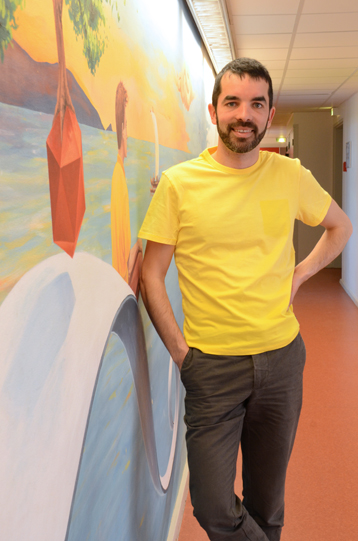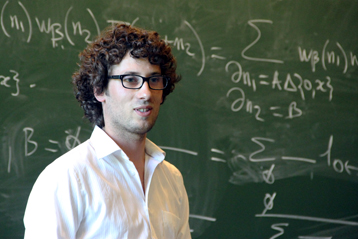
Vincent Calvez and Hugo Duminil-Copin awarded the European Mathematical Society Prize
Two young mathematicians from France are among the ten recipients of the 2016 European Mathematical Society (EMS) prize: Vincent Calvez, chargé de recherche CNRS at l'Unité de mathématiques pures et appliquées (CNRS/ENS de Lyon) and member of the Inria NuMed project team, as well as Hugo Duminil-Copin, professor at l'Université de Genève, who in September 2016 will join the Laboratoire Alexander Grothendieck (CNRS/IHÉS). These prizes, which are given every four years to mathematicians under 35 years of age who are from or who work in Europe, will be announced and awarded at the opening of the 7th European Congress of Mathematics scheduled to take place in Berlin from July 18-22, 2016.
On the occasion of the quadrennial European Congress of Mathematics, the European Society of Mathematics will award, among others, ten prizes to young mathematicians who are from or who work in Europe. Previous recipients include Wendelin Werner, Cédric Villani, and Artur Avila, who all went on to win the Fields medal, considered to be the equivalent of the Nobel Prize in mathematics. This year, these prizes will notably reward two French researchers: Vincent Calvez and Hugo Duminil-Copin.
Vincent Calvez, who was born in 1981, works in the field of mathematics applied to biology. He completed interdisciplinary coursework at l'École normale supérieure, obtained the agrégation de mathématiques in 2005, and completed a thesis under the direction of Benoît Perthame in 2007. Since 2008, he has served as chargé de recherche CNRS at l'Unité de mathématiques pures et appliquées (CNRS/ENS de Lyon). He is also part of the Inria NuMed project team, and received the 2014 CNRS bronze medal for his research.
Vincent Calvez's early research involved the modelization of the collective movements of bacteria toward their sources of food. These processes are simulated by transport equations presenting nonlinear interaction terms, which take into consideration the fact that the cells are aggregated. In connection with experimental biologists, Vincent Calvez developed a new model inspired by the kinetic theory of gases. This model describes both the individual movements of bacteria and the transport of colonies as a whole, and satisfactorily explains the specific characters of this movement. Another productive interaction was a collaboration with biophysicists that provided a new explanation for cell polarization, a ubiquitous biological phenomenon. More recently, Vincent Calvez and one of his students created a completely new approach to modelizing invasion fronts in ecology, another example of a phenomenon spreading in the form of waves.
Vincent Calvez is also involved in the popularization of mathematics by coordinating the travelling exhibition “Mathàlyon,” intended for junior high and high school students.
Born in 1985, Hugo Duminil-Copin is a researcher in probabilities. After completing classes préparatoires at the lycée Louis-le-Grand (Paris), he attended l'École normale supérieure in 2006 where he obtained the agrégation de mathématiques. In 2012 he completed his thesis under the direction of Stanislav Smirnov at l'Université de Genève, where he is now professor. His research earned him a selection for the 2015 cours Peccot at the Collège de France. In September 2016, he will join the Laboratoire Alexander Grothendieck (CNRS/IHÉS) as a professor of l'IHÉS.
Hugo Duminil-Copin's research has made considerable contributions to percolation theory, a branch of probability theory that is concerned with the behavior of connected clusters in random graphs. In particular, he is studying random walks, also known as “drunkard's walks” because the direction of each new step is chosen at random. Along with his thesis director Stanislav Smirnov, he is interested in self-avoiding random walks, in which the “drunkard” never returns to a place that has already been visited. The number of possible paths for a number of given steps depends on the network on which the movement is taking place. When there are a large number of steps, its value is expressed simply in accordance with a constant, called the “constant of connectivity.” Hugo Duminil-Copin succeeded in calculating the value of this constant in the case of a honeycomb lattice. These self-avoiding random walks are central to understanding important questions in physics, and are used, for instance, in statistical mechanics, such as the simplified models of polymer chains.
Probability and partial differential equations are two strategic areas of French mathematics, whose vitality is once again demonstrated by the awards received by these young talents. An award honoring interactions between mathematics and biology is also recognition for the considerable investment made by French mathematicians in their dialogue with other disciplines, in an effort to respond to the challenges of today, whether they be societal or environmental.

© Vanessa Cusimano / CNRS DR7

© MFO


